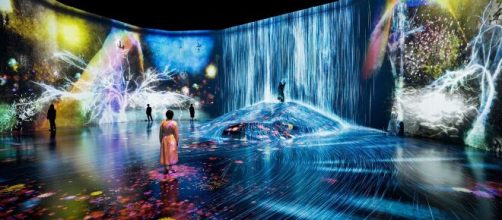It was only a matter of time before the immersive art experience – watching famous paintings bulge over an entire exhibit hall – became an experience without the paintings.
It was an historic inevitability that someone somewhere would set out to prove you can do anything with digital imagery. Who needs art?
An international collective in Tokyo called teamLab, known for immersive art shows of famous painters, now offers a digital experience of a second kind – imagery minus the art of painting.
In its place, you get what the collective calls “borderless imagery” – as if that were a novelty.
(More about that in a moment).
Takashi Kudo, communications director for the collective, says that while visitors may be curious about the mechanics of the borderless show, it’s best not to pay attention to that.
What then? If you say technology is only a tool, what’s the message here? Kudo says: "It’s about a borderless world." There’s that word again.
Does Kudo think that the lack of borders was missing from immersive art shows? Does he think that blow-ups of, say, Van Gogh’s paintings spilling all over floors, walls and ceilings wasn’t engulfing enough?
Amelia Wang, who writes about art in Asia, reviewed teamLab’s effort for Artnet and enthused that this borderlessness – a display of L.E.D.-lit colors and shapes – is “without maps and therefore is without beginning or ending and impossible to navigate.”
In that way, she says, “viewers are encouraged to get lost.”
But, isn’t the world lost enough.
Isn’t art meant to organize the chaos? Who needs a borderless world?
If I understand this correctly, such a display of special effects is like thrilling at an amusement park funhouse with trick mirrors and shifting floors.
Wang makes plain this project is no funhouse activity by repeatedly referring to this extravaganza as “artwork.” Since when does the razzle-dazzle light show add up to an “artwork”?
According to CNN’s report of teamLab’s borderless show, the aim is to “fundamentally change the way we perceive and think about art.”
Say what?
Can a mere light show alter art history? Can it enhance art appreciation? In what universe? And where’s the art?
And why “fundamentally change” the way we think about art?
What’s the matter with the way we’ve been doing it?
Then again, who is teamLab to make the change? By the name alone, the collective sounds like a testing facility for the manufacture of drugs or chemicals.
Greatest Show on Earth
It was bad enough when teamLab gave us immersive art shows. Now, their shows are not only without borders, but also without art. Like Cecil B. DeMille wannabes, this collective seems bent on creating the greatest show on earth. In effect, it’s still a circus.
I’m still reeling from “Beyond Monet,” an immersive show that took the painting past the artist’s intent.
Seeing “Water Lilies” ballooning over 50,000 square feet of Metro Toronto Convention Center, with originally composed music piped in surround sound, Monet’s beloved garden was upstaged.
But wait. I want to be generous here. The world is big enough to take in a light show or what Tokyo calls a “borderless world.” After all, the field of entertainment is wide.
Just stay in your lane teamLab and quit saying you’re going to “fundamentally change the way we perceive and think about art.” You’re not that good.


